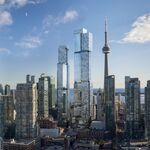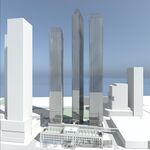Maybe you thought that controversy over the Metrolinx process of choosing future station sites meant that construction wouldn't proceed on those stations. Maybe you thought that Toronto Mayor John Tory's SmartTrack proposal for rapid transit services on local GO rail corridors would never succeed. Well, maybe you'll have to think again…
At a luncheon event at the Toronto and District Board of Trade yesterday, Metrolinx chief executive officer Phil Verster announced that his agency was proceeding to the next stage in developing twelve future GO Transit stations on the Stouffville, Lakeshore East, Barrie and Kitchener rail corridors. Those future stations support the the City of Toronto's SmartTrack frequent rapid transit service or the Metrolinx program of regional express rail service on GO lines.
 Metrolinx chief executive officer Phil Verster (with the red tie) at the Board of Trade, image, Metrolinx
Metrolinx chief executive officer Phil Verster (with the red tie) at the Board of Trade, image, Metrolinx
Verster also told the Board of Trade luncheon group that Metrolinx also intended to proceed with developing an initial business case for a station that it originally left off the list—Park Lawn on the Lakeshore West line.
In 2016, Metrolinx completed the initial business cases for possible stations at 19 sites throughout the Greater Golden Horseshoe area. In June of that year, its board of directors approved proceeding with 12 of those stations, basing its decision on those initial business cases. Six stations are SmartTrack stations—Finch-Kennedy, Lawrence-Kennedy, Gerrard-Carlaw, East Harbour, King-Liberty Village and St. Clair-Old Weston Road. The other six would serve general GO train passengers at Breslau (just east of Kitchener), Innisfil (south of Barrie), Mulock (in Newmarket), Kirby (in Vaughan)--and Bloor-Lansdowne and Spadina-Front in Toronto.
During his speech, Verster pointed to a slide illustrating the new GO stations and highlighted the frequent service that GO and SmartTrack could provide to Toronto. His map shows frequent train service extending northwest along the Kitchener line as far as Bramalea. This outer U of frequent rapid transit, he said, could supply an alternative to the inner U of the TTC Line 1 (Yonge-University) subway.
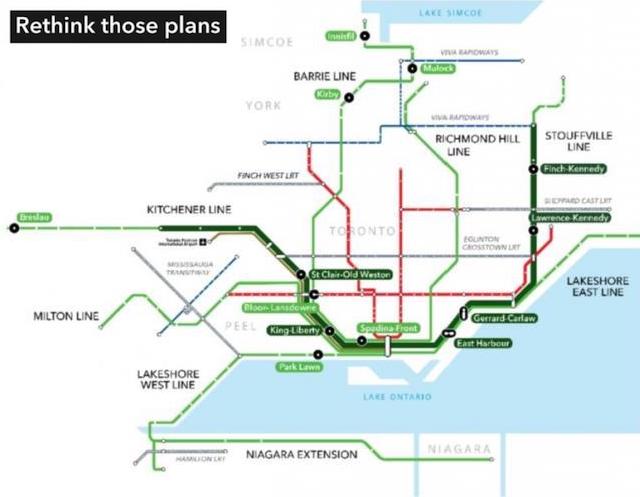 The new stations appear on this map. Frequent trains could operate in a U between Bramalea and Unionville, image, Metrolinx
The new stations appear on this map. Frequent trains could operate in a U between Bramalea and Unionville, image, Metrolinx
The initial business case assumed that all trains on all lines would stop at all stations—and that's where some problems arose, because those new stations would effectively punish passengers "upstream"—travelling to and from areas beyond those stations. Those passengers would suffer longer commutes resulting from extra stops during their trips.
The Toronto Star has previously reported that Ontario's former Transportation Minister Steve Del Duca may have pressured Metrolinx to include two stations that the transit agencies initial business case did not support—Kirby in Del Duca's riding of Vaughan and Lawrence-Kennedy. Verster dismissed these concerns as "conspiracy theories" but also said he could not speak to events that occurred before he was appointed as CEO.
Now that Metrolinx has completed the next phase of analyzing the locations—the Preliminary Design Business Case phase—the regional transit agency is supporting most of the stations even more emphatically. In this phase, independent analysts further weighed each new stops' benefits against their costs.
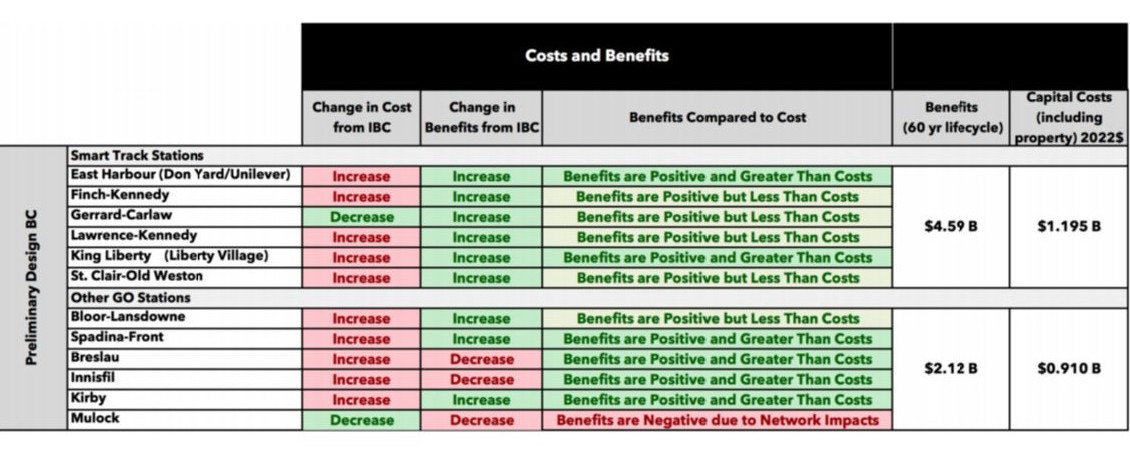 During this phase, analysts further weighed the benefits and costs of new stations, image, Metrolinx
During this phase, analysts further weighed the benefits and costs of new stations, image, Metrolinx
Verster used a hypothetical model to simplify this process for those who are not experts. If, for example, a train stops for two minutes at each station, while passengers exit from and board coaches, and each train carries 1,000 people, then each new station represents a negative on the balance sheet of 2,000 minutes. On the other had, if each new station saves 100 people five minutes less time commuting, then each site gains 500 minutes on the plus side.
Unlike during the initial business case, Metrolinx also proposed "three key policy, infrastructure and operational advancements" that positively impacted the stations' benefits during this stage of planning.
Those changes include:
- operating express trains—Trains from the outer ends of each line would operate express along the inner parts of the line. For example, on the Stouffville corridor, trains might pick up passengers at all stations between Lincolnville and Unionville, then operate with few stops between Unionville and Union Station. Local trains would serve all stops south of Unionville. This means that building new stations no longer penalizes upstream passengers.
- introducing level boarding—Passengers could board from platforms that are level with the trains. If commuters no longer have to have to step up into or step down out of coaches, then Metrolinx could further reduce the time that trains have to dwell in stations by at least 30 seconds.
- integrating fares—Metrolinx now assumes that fares for both regional and local transit agencies would be equal and that passengers would not have to pay extra to transfer between systems. This would attract even more passengers to the new stations, especially in Toronto, because TTC and GO fares would usually be the same. (Although Metrolinx may also consider fares by distance or fares by zone.)
With these new criteria in place and other factors, most of the new stations earn greater benefits under this second phase of analysis, although most also would cost more that the initial business cases revealed. All new stations except for Breslau, Innisfil and Mulock would benefit passengers more than the first business cases suggested. All except Gerrard-Carlaw and Mulock would cost more.
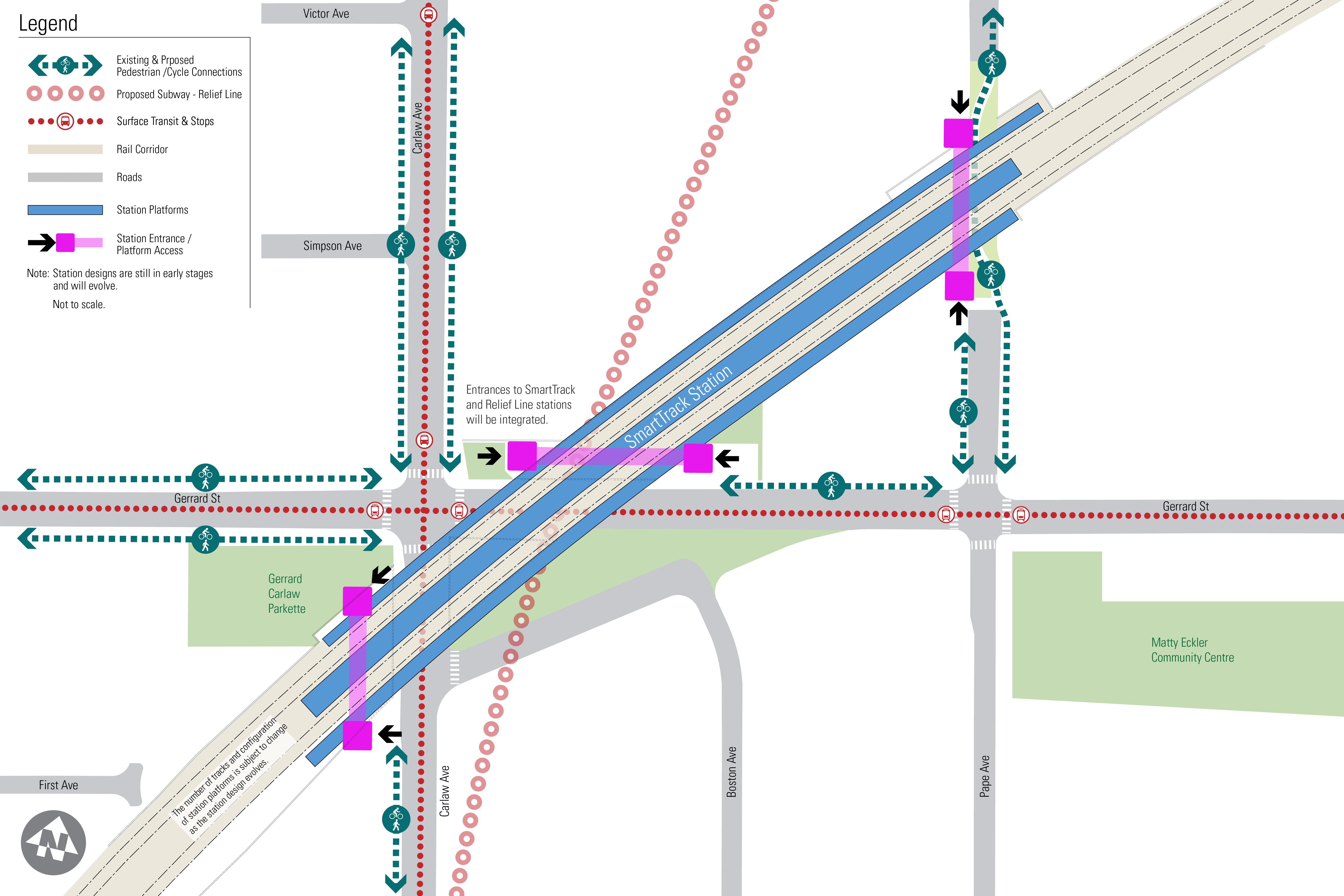 The graphic illustrates a preliminary concept for the Gerrard-Carlaw Station, image, City of Toronto
The graphic illustrates a preliminary concept for the Gerrard-Carlaw Station, image, City of Toronto
Under the preliminary design business case process, the benefits of all the SmartTrack stations would exceed the costs. According to a Metrolinx staff report, the combined net benefits are $4.59B and while the combined costs are $1.195B. East Harbour and Liberty Village benefit from current or proposed major employment centres nearby. Finch-Kennedy, Gerrard-Carlaw, Lawrence-Kennedy and St. Clair-Old Weston, the report says, would attract riders from nearby residential areas and provide overall transportation user benefits. The positive benefits, Metrolinx explains, generally exceed the impacts because the new stations would attract new off-peak riders.
Mayor John Tory reacted happily to the news that SmartTrack would deliver nearly four dollars in economic and social benefits for every dollar spent on construction costs. Tory said in a press release, "The latest Metrolinx analysis makes it clear the case for SmartTrack is getting stronger. We are getting on with building SmartTrack because it can be done quickly, and will provide relief faster for TTC riders on the Yonge-University-Spadina line."
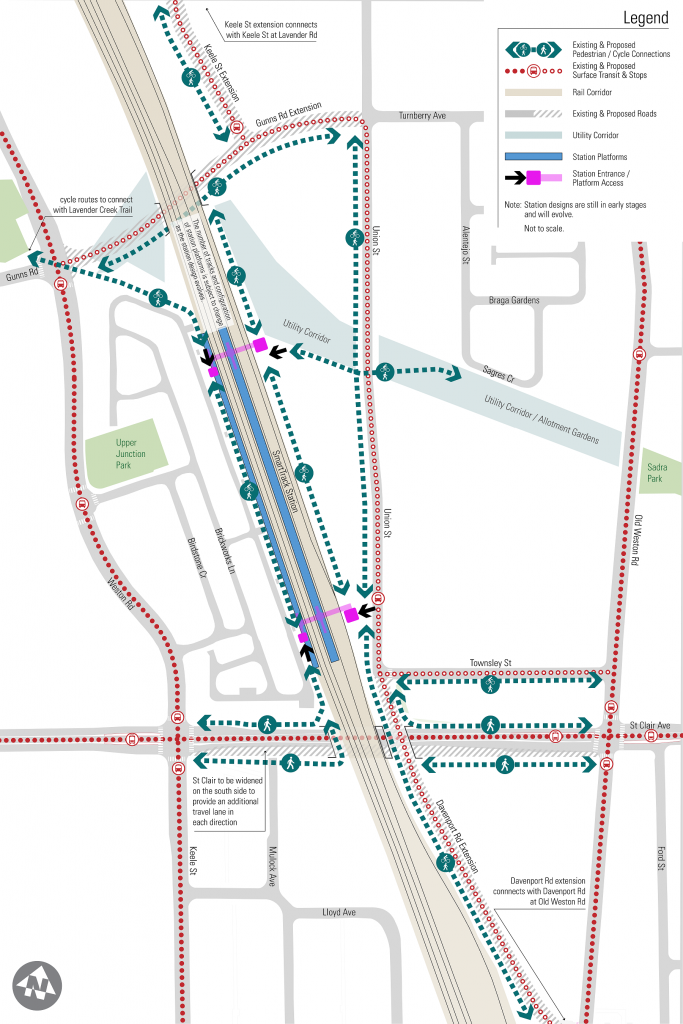 The future St. Clair-Old Weston station may require a redesign of the local road network, image, City of Toronto
The future St. Clair-Old Weston station may require a redesign of the local road network, image, City of Toronto
For the six other GO regional express rail stations, the combined benefits also exceed the costs. The net benefits are $2.1B, while the cost is $0.19B. The staff document explains that Spadina-Front station benefits from current and future plans to intensify the Downtown / Central Waterfront area. Bloor-Lansdowne allows passengers to conveniently transfer to frequent subway service on the TTC's Line 2 (Bloor-Danforth) subway. Breslau, Innisfil and Kirby stations provide new access points to the GO system. However, Metrolinx needs to further analyze the benefits of its proposal to install a new station at Mulock.
The initial business cases for new GO stations did not support a stop at Park Lawn due to its location near Mimico GO Station. However, the station could significantly improve transit for the growing Humber Bay Shores area and future employment or residential developments nearby. If this station proceeds, Metrolinx would split Lakeshore West service so that some trains would stop in Mimico only, while others would only serve Park Lawn.
We will continue to update you as these plans progress. What do you think? Join the conversation by leaving your comments in the form below or by participating in our Forum discussion.

 3K
3K 
























